Cigars are a premium tobacco product, renowned for their unique flavor, rich aroma, and complex taste. Unlike regular cigarettes, the production process of cigars is more intricate and refined. Crafting a cigar involves several detailed steps, from cultivation to the final product, with each stage being crucial. The main processes include tobacco leaf cultivation and harvesting, drying, fermentation, rolling, and finished cigar storage, with fermentation being the key step in enhancing quality. Fermentation is not only a physical transformation but also a process of chemical and biological changes. During fermentation, complex organic substances in the tobacco leaves, such as carbohydrates, proteins, starches, cellulose, and fats, are decomposed and transformed by microorganisms and enzymes, producing a variety of aromatic substances and flavor compounds (Si et al., 2023; Li et al., 2020; Banožić et al., 2020). These aromatic substances, including carotenoid degradation products, chlorophyll degradation products, and Maillard reaction products, impart the cigar with its distinctive aroma and complex flavor, clearly distinguishing it from regular cigarettes (Fu et al., 2024; Rodriguez-Bustamante et al., 2005). Fresh tobacco leaves contain some undesirable odors and irritants, such as ammonia, nicotine, and various phenolic compounds. During fermentation, these substances are degraded or transformed into milder compounds by microbial activity, significantly reducing the harshness and unpleasant odors of the tobacco leaves (Zhang et al., 2024; Ning et al., 2023). This process not only enhances the smoking experience but also results in smoke that is smoother and sweeter during combustion. Furthermore, fermentation can alter the physical structure of the tobacco leaves, making them softer and more elastic, which is more suitable for cigar rolling. During fermentation, macromolecules such as pectin and cellulose in the tobacco leaves are partially degraded, leading to changes in the leaf tissue structure. These changes increase flexibility and rollability. This transformation not only facilitates the rolling of high-quality cigars but also improves the uniformity and durability of the cigar’s burn during smoking (Dai et al., 2020). Most importantly, fermentation can reduce the levels of certain harmful substances in the tobacco leaves. Through fermentation, the safety of cigars is improved, as harmful substances like nitrates, nitrites, and heavy metals are metabolized or transformed by microorganisms, thereby reducing their potential health risks (Li et al., 2023; Ning et al., 2023). In summary, the fermentation process is critical in enhancing aroma and flavor, eliminating undesirable odors and irritants, improving physical properties, reducing harmful substances, and stabilizing chemical composition. These improvements not only elevate the quality and smoking experience of cigars but also provide a strong competitive edge in the market.
Pectin is a complex polysaccharide, primarily composed of galacturonic acid units linked by α-1,4-glycosidic bonds, and is widely present in plant cell walls (Thakur et al., 1997; Mohnen, 2008). In tobacco leaves, pectin is a major component of the cell wall and intercellular matrix, with its content and degradation directly influencing the leaves’ physical and chemical properties. During fermentation, pectin is broken down by microorganisms and enzymes into various low-molecular-weight compounds, such as galacturonic acid, oligosaccharides, and other organic acids, which significantly impact the taste of tobacco leaves (Bedzo et al., 2023; Kratchanova et al., 1995). Organic acids, such as galacturonic acid, produced during pectin degradation, are the main sources of green bitterness. Their high acidity directly affects the tobacco leaves’ flavor, imparting a strong green bitterness (Weng et al., 2024). For example, galacturonic acid can metabolize into simple organic acids like formic acid and acetic acid, which, in high concentrations, impart a strong bitterness. Additionally, microbial metabolism during pectin degradation can produce aldehydes and ketones, compounds with pungent odors and bitter tastes, further negatively affecting the tobacco’s sensory quality (Yang et al., 2022). When fermentation is incomplete or poorly controlled, these bitter compounds can accumulate, intensifying the green bitterness of the tobacco leaves. Pectin degradation may also generate volatile organic compounds, such as methanol and ethanol, which, at high concentrations, can negatively impact the aroma and taste of tobacco leaves, increasing the perception of green bitterness (Zhu et al., 2014; Zhao et al., 2024). If pectin content is too high and not fully degraded during fermentation, the remaining pectin can continue to release bitter compounds, leading to strong green bitterness during smoking. Moreover, high pectin content can result in uneven microbial distribution and activity during fermentation, leading to incomplete pectin degradation in some areas, causing localized intense green bitterness (Zhang et al., 2024; Song et al., 2024). Therefore, effective fermentation management and techniques are required during cigar fermentation to significantly reduce pectin content and minimize green bitterness, thereby improving the overall quality of the tobacco leaves.
Pectin-degrading bacteria are microorganisms capable of efficiently degrading pectin, and they hold significant potential for application in cigar fermentation. By introducing pectin-degrading bacteria, the pectin content in tobacco leaves can be significantly reduced, thereby decreasing bitterness and astringency while enhancing the aroma and flavor of the tobacco. These strains rapidly secrete large amounts of pectinases, including pectin lyase and polygalacturonase, which quickly break down pectin into monosaccharides and oligosaccharides, reducing the formation of bitter compounds (Weng et al., 2024; Rehman et al., 2015). Furthermore, pectin-degrading bacteria exhibit strong adaptability under various fermentation conditions, maintaining activity in high-salt, low-pH, and fluctuating temperature environments, ensuring the stability and continuity of the fermentation process (Zhao et al., 2024; Nograšek et al., 2015). In addition to pectinases, some pectin-degrading bacteria also secrete other degradative enzymes, such as cellulases and xylanases, which synergistically act on the complex carbohydrates in tobacco leaves, further improving their physical and sensory qualities (Zheng et al., 2017; Bonnin et al., 2014). Moreover, pectin-degrading bacteria can inhibit the growth of harmful microorganisms through competitive inhibition, reducing the production of harmful metabolites and further enhancing the quality of fermented tobacco leaves (Li et al., 2024; Soriano et al., 2005). Therefore, effective fermentation management and the addition of pectin-degrading bacteria during cigar fermentation can significantly reduce pectin content, lessen green bitterness, and enhance the overall quality of tobacco leaves. This approach offers new strategies for optimizing fermentation and improving product quality.
In this study, high-quality healthy cigar tobacco leaves were used to screen for pectin-degrading bacteria, which were then applied in cigar fermentation. The relationships between the physicochemical properties of the tobacco leaves after fermentation and the microbial communities were examined through comparative analyses using Mantel test association network heatmaps, correlation heatmaps, and microbial network analyses. Understanding the complex interactions between microbial communities and the physicochemical properties of tobacco leaves enables better optimization of the fermentation process and aids in selecting suitable bacterial combinations, ultimately improving the quality of the tobacco leaves. This study provides scientific evidence for the contribution of pectin-degrading bacteria to the quality of cigar fermentation.
2 Materials and methods 2.1 Isolation and identification of pectin-degrading bacteriaUsing the dilution plate method, healthy cigar tobacco leaf samples were ground with a mortar. 1 g of the ground sample was added to a test tube, and sterile water was added until the total volume reached the 10 mL mark. The tube was then sealed and shaken vigorously for 30 min. The supernatant was serially diluted to 104 and 105 fold, and 100 μL of the diluted solution was evenly spread onto NA medium. The plates were incubated at 28°C in a constant temperature incubator for 3 days. Colonies with distinct morphologies were isolated and purified on NA medium. The purified strains were then inoculated onto pectinase screening medium, and after 48 h, the formation of clear zones was observed. The hydrolysis capacity value (HC value) was then calculated using the following formula (Harnvoravongchai et al., 2020):
In the formula: d1 represents the diameter of the clear zone (including the colony) in millimeters (mm), and d0 represents the diameter of the colony in millimeters (mm).
The 16S rDNA sequence is a crucial marker for species identification. The 16S rDNA gene of the strain was amplified using universal primers 27F-1492R via PCR. The forward primer used was 27F (sequence: TACGGYTACCTTGTTACGACTT), and the reverse primer was 1492R (sequence: AGAGTTTGATCMTGGCTCAG). The amplified product was approximately 1.5 K in length, and the PCR product was sequenced by Shanghai Rongxu Biotechnology Co., Ltd. The sequencing results were submitted to the NCBI (National Center for Biotechnology Information) database for nucleic acid sequence comparison using the BLAST program. A phylogenetic tree was constructed using the neighbor-joining method in MEGA11 software.
2.2 Pectin-degrading bacterial enzyme activity assayThe enzyme activity of the strains was determined using the DNS pectinase assay kit from Nanjing Jiancheng Bioengineering Institute. Pectin-degrading bacteria were inoculated into a medium containing pectin as the sole carbon source to induce the production of pectinase. After a period of cultivation, the bacterial culture was collected and centrifuged, and the supernatant was used as the enzyme solution. A 50 mL aliquot of enzyme solution was taken, with 50 mL of distilled water used as the blank control. Pectin substrate solution was added, and the enzymatic reaction was carried out at 35°C and pH 5.5. After a set period, DNS reagent was added to terminate the reaction, and the mixture was placed in a boiling water bath for 5 min. The absorbance was measured using a spectrophotometer at a wavelength of 540 nm, and the OD value of each tube was recorded. The enzyme activity was then calculated by inputting the measured data into the corresponding formula.
CLactivityU/mL=Atest−AcontrolAstandard−Ablank×Cstandard×Vtotal×VsampleVextraction×W/T 2.3 Cigar fermentation experiment designUniformly sized cigar tobacco leaves without mechanical damage or infection were selected for fermentation in an incubator. The fermentation conditions in this study simulated the actual industrial fermentation conditions of the Modu Cigar Tobacco Drying and Fermentation Management Workshop in Ede, Mosha Town, Xinping County, Yuxi City, Yunnan Province, China. To assess the impact of pectin-degrading bacteria on the quality of cigar fermentation, the two most potent strains were selected and each was inoculated into 150 mL of NB medium. The cultures were incubated at 180 r/min and 28°C for 48 h. After incubation, the seed cultures were centrifuged, and the resulting cell pellets were resuspended in 150 mL of distilled water to prepare the bacterial fermentation solutions. Three treatment groups were designed, with specific inoculants as follows: pure water, 1 × 108 CFU/mL YX-2 fermentation broth, and 1 × 108 CFU/mL DM-3 fermentation broth. These groups were: the CK group (fermented with pure water only), the TYX2 group (fermented with YX-2 fermentation broth only), and the TDM3 group (fermented with DM-3 fermentation broth only). Each treatment had 5 replicates. The ratio of fermentation broth to tobacco leaf mass was set at 1:50. The detailed experimental design is depicted in Figure 1. After fermentation, tobacco leaf samples were collected to assess relevant physicochemical properties and analyze microbial community diversity.
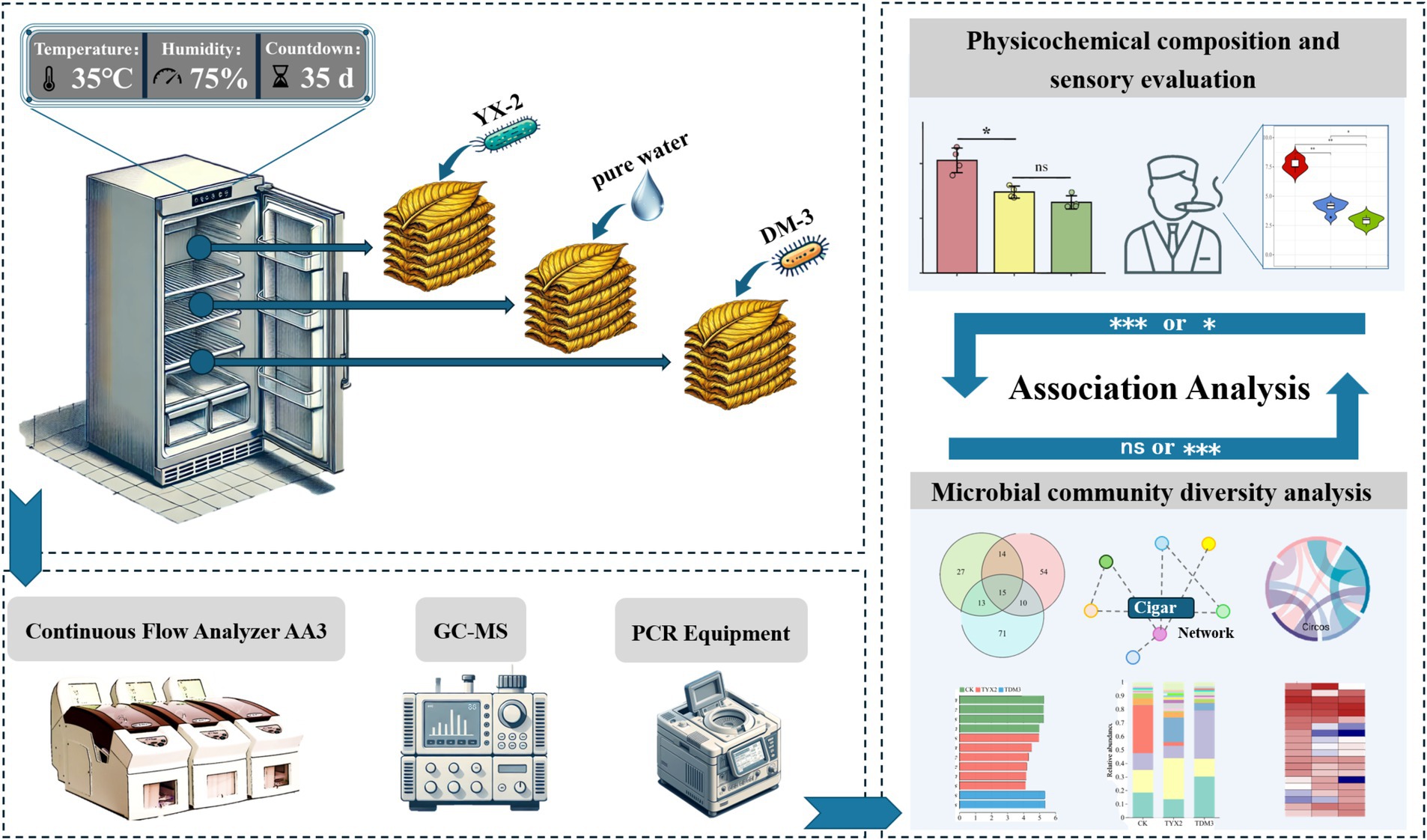
Figure 1. Experimental design.
2.4 Analysis of physicochemical composition and sensory evaluation of tobacco leafSamples for analysis were uniformly collected from the center of the cigar tobacco leaves in each treatment group. The samples were ground into a fine powder using a pestle in liquid nitrogen and subsequently stored in an ultra-low temperature freezer at −80°C. The physicochemical composition of the tobacco leaves, including total nitrogen, pectin, total sugars, reducing sugars, and total alkaloids, was then measured. Refer to Table 1 for the standards on which the test methods are based (Fu et al., 2024; Ren et al., 2023).
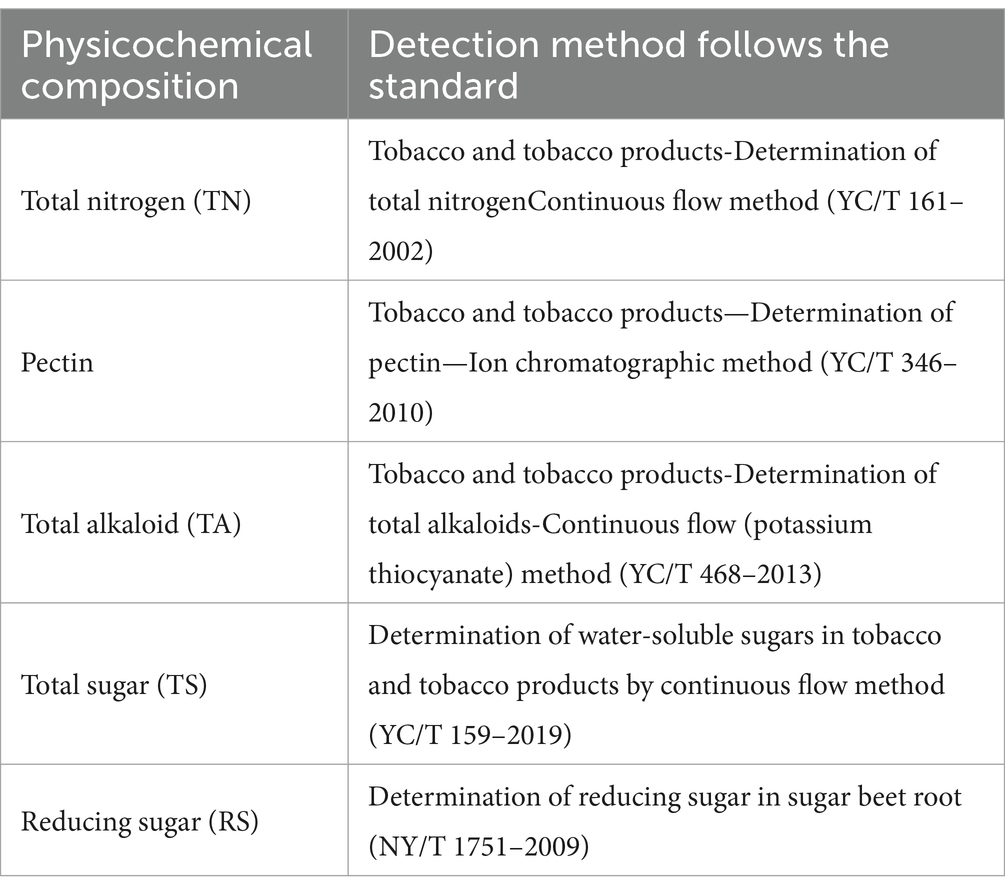
Table 1. Methods and equipment for testing physicochemical composition of cigar.
A gas chromatography–mass spectrometry (GC–MS) system (7890A/5975C, Agilent, United States) was used to analyze aroma components. The tobacco leaves were dried, ground, and sieved, and 20.00 grams of the sample was weighed and mixed with 350 mL of distilled water and 1 mL of 20 μg/mL internal standard solution (n-heptadecane) in a 1-liter round-bottom flask. Separately, 60 mL of dichloromethane was added to a 100 mL flat-bottom flask as the extraction solvent. The round-bottom flask was heated to boiling using a heating mantle, while the extraction flask was heated in a 60°C water bath, and the extraction was conducted for 3 h. The dichloromethane extract was then dried overnight with 10 grams of anhydrous sodium sulfate, concentrated to 1 mL, and transferred to a chromatography vial for GC–MS analysis. The aroma compounds were classified according to their precursor substances into chlorophyll degradation products, carotenoid degradation products, Maillard reaction products, and cembranoid degradation products (Rodriguez-Bustamante et al., 2005).
After fermentation, the samples were rolled into finished cigars and randomly labeled. Five sensory evaluation experts were organized to assess green bitterness in the cigars, following the GB 15269.4–2011 national standard, Cigars - Part 4: Technical Requirements for Sensory Evaluation (Weng et al., 2024). The total score for this evaluation was 10 points, with 0 < b ≤ 2.5 indicating “No green bitterness,” 2.5 < b ≤ 5.0 indicating “Mild green bitterness,” 5.0 < b ≤ 7.5 indicating “Moderate green bitterness,” and 7.5 < b ≤ 10 indicating “Strong green bitterness.
2.5 Interactive analysis of microbial diversity using the QIIME2 pipelineFirst, genomic DNA was extracted and verified using 1% agarose gel electrophoresis. PCR amplification was performed with specific barcoded primers, utilizing TransStart Fastpfu DNA Polymerase and an ABI GeneAmp® 9,700 PCR system. To ensure the generation of adequately concentrated PCR products, low cycle numbers were employed, with consistent cycle numbers maintained across all samples. All samples were processed under standard experimental conditions, with five replicates per sample. The PCR products from the same sample were pooled and analyzed using 2% agarose gel electrophoresis. The amplified products were excised from the gel using the AxyPrep DNA Gel Extraction Kit, eluted with Tris–HCl, and verified by a second 2% agarose gel electrophoresis. Based on the preliminary quantification results from the gel electrophoresis, the PCR products were quantified using the QuantiFluor™-ST Blue Fluorescence Quantification System and subsequently pooled according to the sequencing requirements for each sample. For library preparation, adapter sequences were added to the target regions via PCR. The PCR products were excised from the gel using the Gel Extraction Kit, eluted with Tris–HCl buffer, and verified by 2% agarose gel electrophoresis. The DNA fragments were then denatured with sodium hydroxide to produce single-stranded DNA, prepared using the TruSeq™ DNA Sample Prep Kit. During sequencing, the adapter sequences hybridized to complementary sequences on the chip, anchoring the DNA fragments. The DNA fragments served as templates for PCR synthesis of the target sequences. Through denaturation and annealing, “bridges” were formed, followed by PCR amplification to generate DNA clusters, which were then linearized into single strands. Modified DNA polymerase and four types of fluorescently labeled dNTPs were added, with only one nucleotide being incorporated per cycle. A laser was used to scan the surface of the reaction plate, detecting the type of nucleotide added at each cycle. The “fluorescent groups” and “terminating groups” were chemically cleaved, restoring the 3′ end for continued nucleotide incorporation. Finally, the fluorescent signals collected at each cycle were analyzed to determine the sequence of the template DNA fragments.
The hypervariable V3-V4 regions of the bacterial 16S rRNA gene were amplified using the primer pair 799F (5′-AACMGGATTAGATACCCKG-3′) and 1193R (5′-ACGTCATCCCCACCTTCC-3′). The hypervariable ITS1F-ITS2R regions of the fungal gene were amplified using the primer pair ITS1F (5′-CTTGGTCATTTAGAGGAAGTAA-3′) and ITS12R (5′-GCTGCGTTCTTCATCGATGC-3′). After obtaining the paired-end reads during sequencing, the samples were demultiplexed, and the paired-end reads underwent quality control and filtering. The reads were then merged based on their overlap, resulting in optimized, quality-controlled data. The optimized data were subsequently processed using sequence denoising methods such as DADA2 or Deblur to obtain Amplicon Sequence Variant (ASV) representative sequences and their corresponding abundance information. Based on this information, a series of statistical and visualization analyses were conducted, including species taxonomy analysis, community diversity analysis, species differential analysis, correlation analysis, phylogenetic analysis, and functional prediction analysis.
2.6 Statistical analysisStatistical analysis of the HC values of the strains, physicochemical properties of the tobacco leaves, and sequencing data was performed using Excel 2019 and SPSS 26.0 software. One-way ANOVA was used to assess differences in physicochemical properties, microbial diversity, and community composition of the tobacco leaves across different treatments. Pearson correlation analysis was employed to investigate potential correlations between microbial communities and the physicochemical properties of the tobacco leaves. Alpha diversity, based on the Sobs, Shannon, and Simpson indices, was utilized to examine species diversity differences between treatments. Community analysis calculations and visualizations were conducted using R software along with the packages “vegan,” “phyloseq,” “DESeq2,” and “picante.”
All data are presented as “mean ± standard error,” and graphs were generated using Excel 2019, GraphPad Prism 8.0, and Matlab 2019 software.
3 Results 3.1 Isolation and identification of pectin-degrading bacteriaThe HC value is a method used to quantitatively analyze the degradation ability of microorganisms in media containing specific substrates, such as pectin. By measuring the diameter of the clear zone around the microbial colony, the enzyme activity of the strain can be assessed, enabling the rapid screening of strains with pectin-degrading capabilities. In this study, 14 pectin-degrading bacterial strains were isolated, and their degradation effects are shown in Figure 2. Among these, strains YX-2 and DM-3, isolated from ‘Yunxue No. 1’ tobacco leaves collected in Gasa Town, Xinping County, Yuxi City, Yunnan Province, formed the largest clear zones on the pectin-containing medium, with HC values significantly higher than those of other strains, indicating the strongest pectin-degrading ability. In summary, during cigar fermentation, strains YX-2 and DM-3 demonstrate considerable potential for reducing the green bitterness caused by high pectin content in tobacco leaves. Therefore, these strains were selected for further experiments in this study.
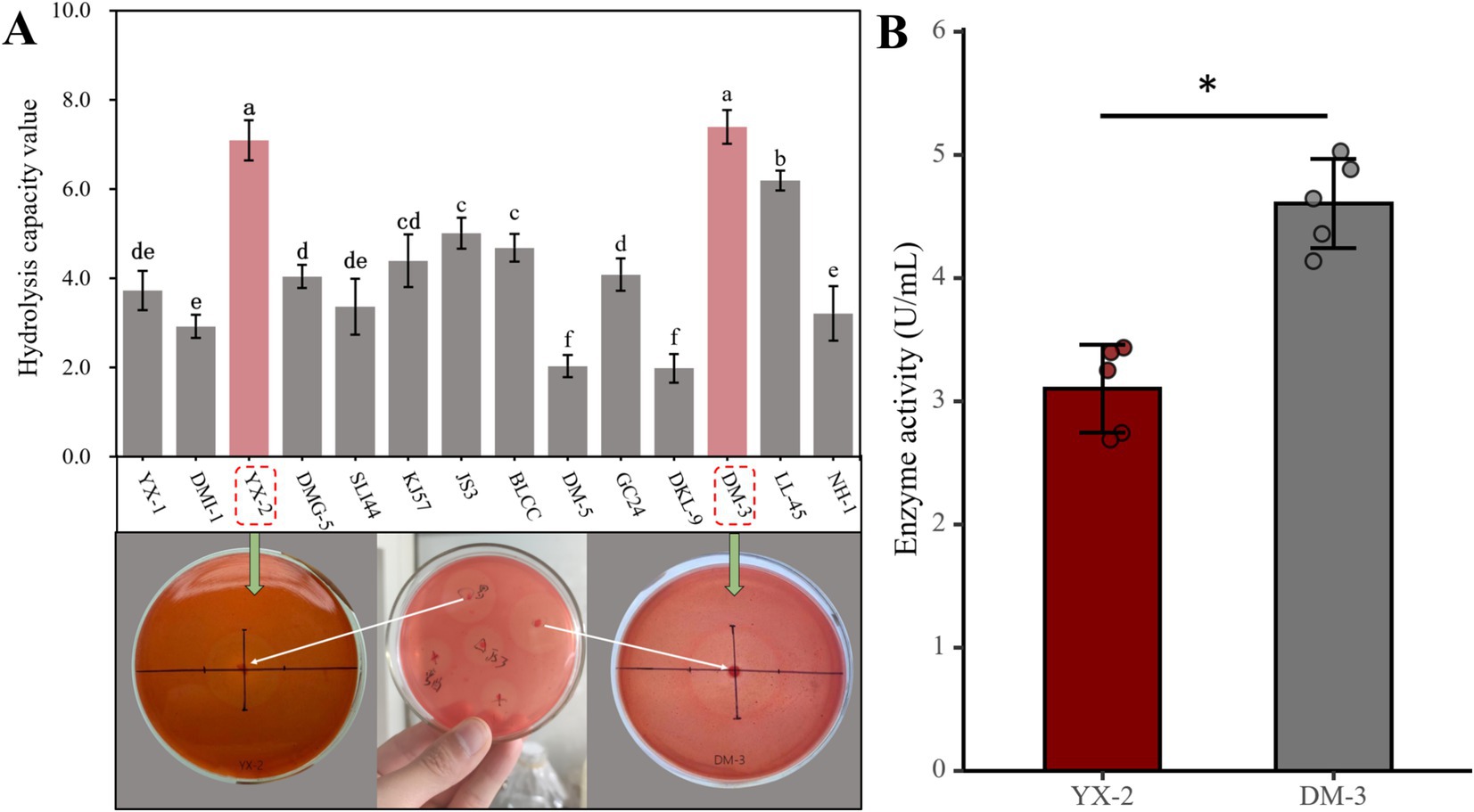
Figure 2. Pectinolytic strain screening results. (A) Shows the HC values of 14 pectinolytic strains, and (B) illustrates the pectinase activity of the two strongest pectinolytic strains.
The 16S rDNA gene sequence of strain YX-2 was analyzed using BLAST on the NCBI platform, and reference sequences with high similarity were downloaded to construct a phylogenetic tree using MEGA11 software, as shown in Figure 3. Strain YX-2 clustered with B. flexus in the GenBank database, exhibiting 99.96% sequence homology with Bacillus flexus strain SBANHT3, indicating a highly reliable taxonomic relationship, and was preliminarily identified as B. flexus. Meanwhile, strain DM-3 was positioned on a branch of the phylogenetic tree near B. siamensis, clustering with B. siamensis in the GenBank database. The branches between DM-3 and its closest relatives, Bacillus siamensis strain IMB16-050 and Bacillus siamensis strain Mp4-Ha30, showed more than 99% homology, indicating that DM-3 has a high genetic similarity to these strains and was preliminarily identified as B. siamensis.
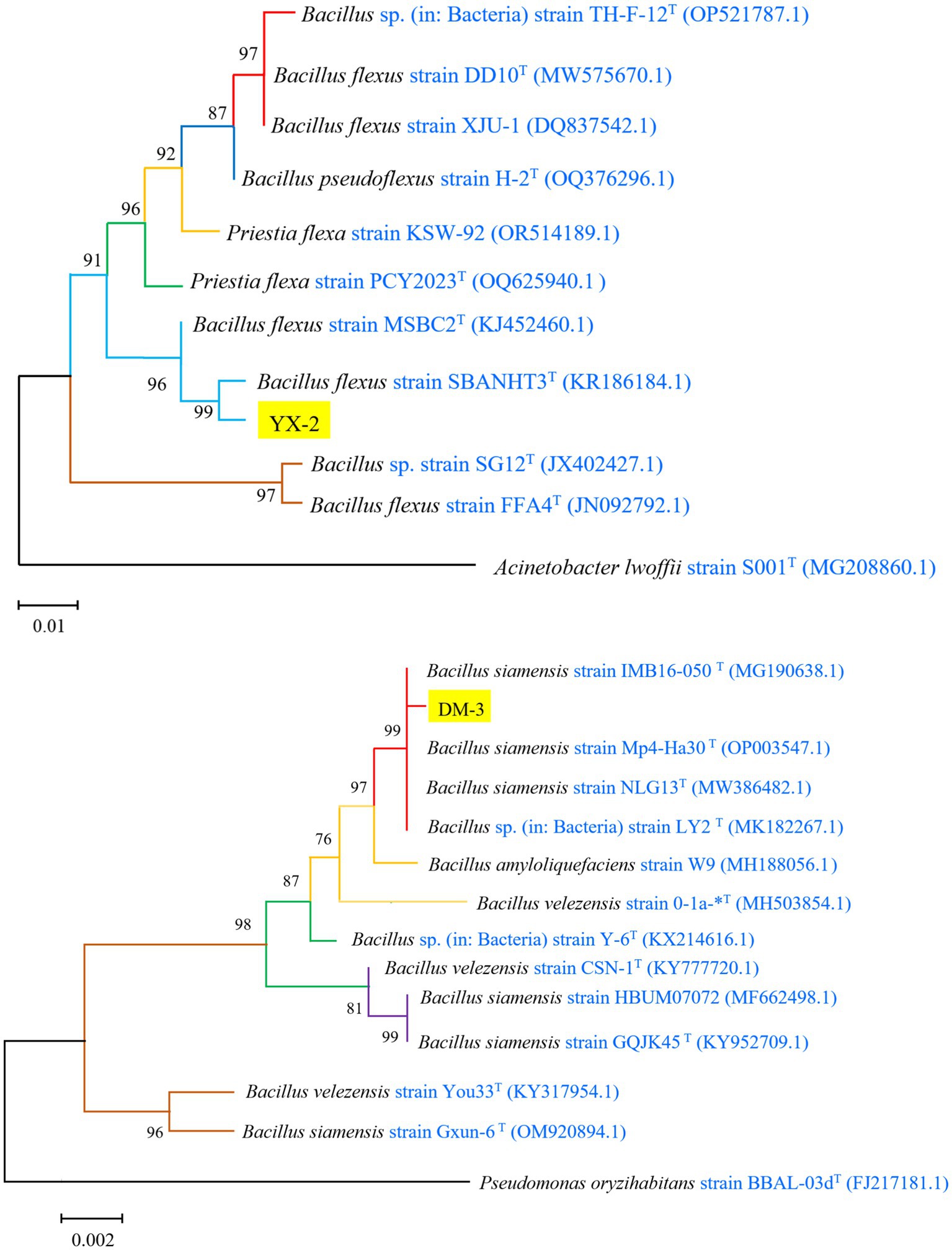
Figure 3. Phylogenetic tree of strains YX-2 and DM-3 constructed using the neighbor-joining method.
3.2 Analysis of differences in physicochemical composition among different treatment groupsThis study aimed to investigate the effects of two pectin-degrading bacteria on the physicochemical properties of tobacco leaves. After 35 days of fermentation, levels of total nitrogen (TN), pectin, total sugars (TS), reducing sugars (RS), total alkaloids (TA), and total flavor components were analyzed in the cigar tobacco leaves (Figure 4). In terms of total nitrogen content, both strains significantly increased levels compared to the CK group, with tobacco leaves fermented with strain DM-3 showing a total nitrogen content of approximately 5.27%, significantly higher than those in the CK and TYX2 groups. The total nitrogen content in the YX-2 strain also increased (to 4.28%) but was not as significant as in the DM-3 strain. Regarding pectin content, the addition of strains YX-2 and DM-3 significantly reduced the pectin content in the tobacco leaves to approximately 7.39 and 6.45%, respectively, which was significantly lower than the CK group’s 10.29%. This indicates that both strains YX-2 and DM-3 possess strong pectin-degrading abilities. In terms of total sugars and reducing sugars, both strains YX-2 and DM-3 significantly increased levels of total and reducing sugars in the tobacco leaves, significantly higher than those in the CK group. This suggests that these strains not only degrade pectin but also promote the hydrolysis of polysaccharides and the accumulation of sugars, enhancing the flavor of the tobacco leaves. In terms of total alkaloid content, tobacco leaves fermented with strains DM-3 and YX-2 showed significantly lower total alkaloid content compared to the CK group’s 5.32%, with strain YX-2 contributing more significantly to the reduction in alkaloid content. Regarding total flavor components, the addition of strains YX-2 and DM-3 significantly increased the levels of total flavor components in the tobacco leaves, reaching approximately 5.32 mol/L and 5.72 mol/L, respectively, significantly higher than the CK group’s 4.33 mol/L. Strain DM-3, in particular, showed more pronounced effects, especially in the production of Maillard reaction products and chlorophyll degradation products, which are important contributors to the enhancement of tobacco leaf aroma quality.
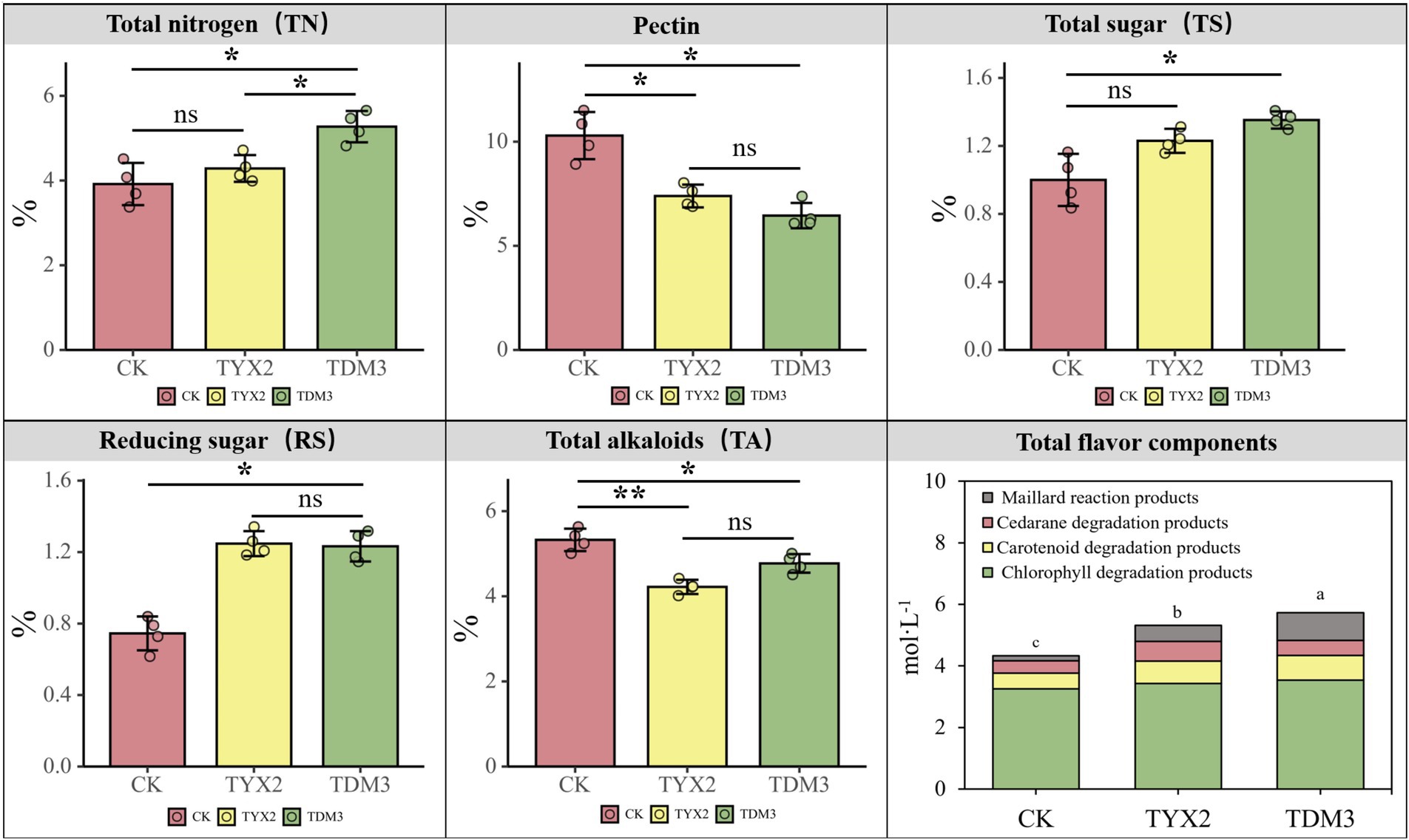
Figure 4. Differences in the contents of total nitrogen (TN), pectin, total sugars (TS), reducing sugars (RS), total alkaloids (TA), and total flavor components among the three treatment groups.
High pectin content is a key factor contributing to the green bitterness experienced during cigar smoking. In this study, five sensory evaluation experts were invited to score the green bitterness of the three treatments (Figure 5). The results showed that after 35 days of fermentation, the CK group had the highest green bitterness score, around 7.5, indicating strong green bitterness. The TYX2 group had a significantly lower score of 4.8, indicating mild green bitterness. The TDM3 group had the lowest score, at 3.5, clearly falling into the mild green bitterness category, with a significant reduction compared to the TYX2 group. When combined with the earlier analysis of physicochemical composition, the addition of strains YX-2 and DM-3 significantly reduced the pectin content in the tobacco leaves, with both treatments showing levels significantly lower than the CK group. The reduction in pectin content directly correlates with the decrease in green bitterness, and the sensory evaluation results support this finding. Therefore, during the fermentation process of cigars, strains DM-3 and YX-2 can effectively reduce the green bitterness generated during smoking by degrading pectin, thereby improving the overall quality of the tobacco leaves.
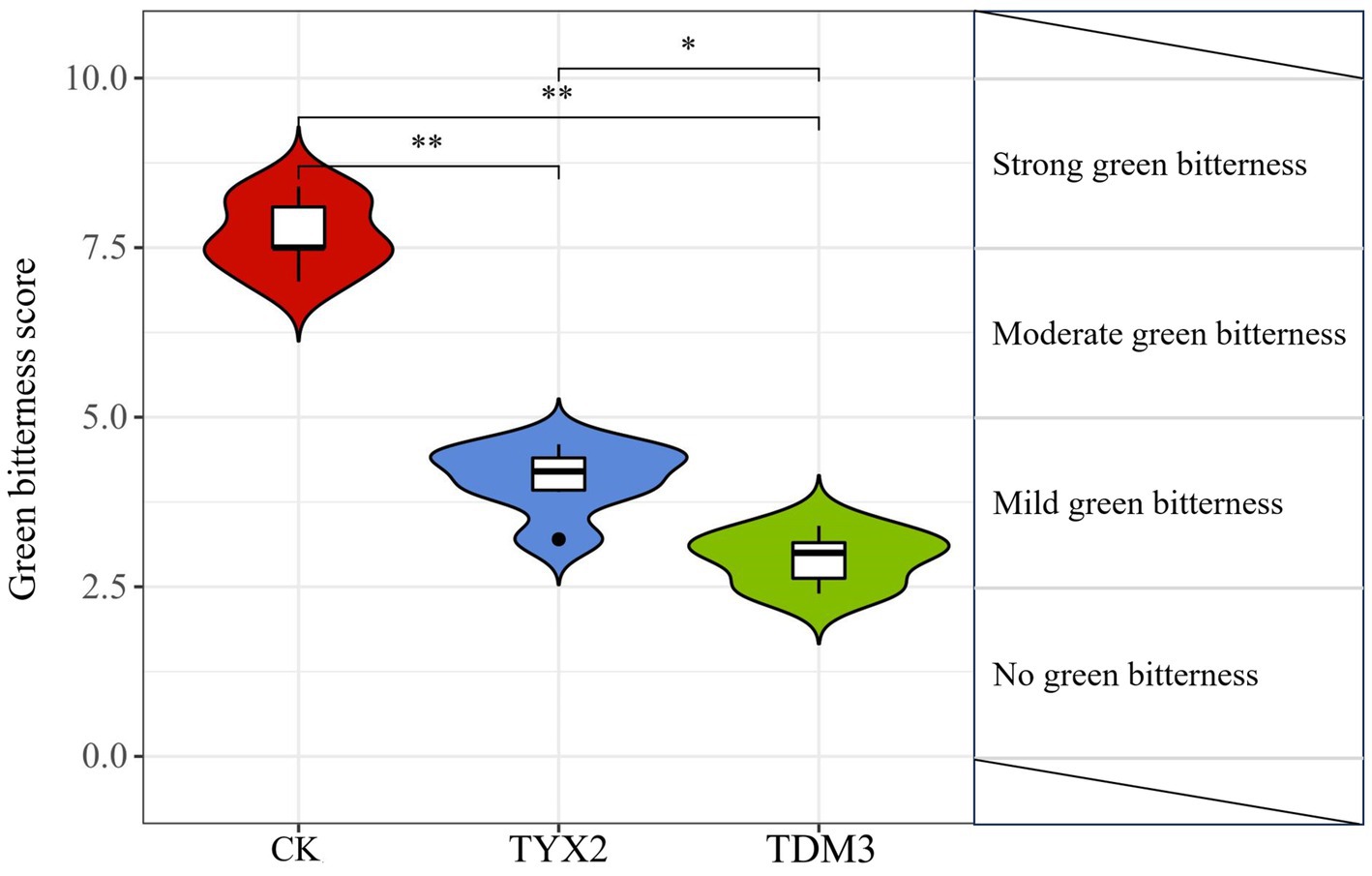
Figure 5. Green bitterness scores for the three treatment groups. The total score for this evaluation was 10 points, with 0 < b ≤ 2.5 indicating “No green bitterness,” 2.5 < b ≤ 5.0 indicating “Mild green bitterness,” 5.0 < b ≤ 7.5 indicating “Moderate green bitterness,” and 7.5 < b ≤ 10 indicating “Strong green bitterness.
3.3 Analysis of differences in tobacco leaf microbial community composition after the addition of pectin-degrading bacteriaThe Venn diagram illustrates the bacterial and fungal genus-level counts across the three treatment groups (Figure 6). The results show that the TYX2 group had 54 unique bacterial genera, and the TDM3 group had 71 unique bacterial genera, both higher than in the CK group. There were 15 common bacterial genera among the groups, indicating their general adaptability under different treatment conditions. At the fungal genus level, the CK group had 67 unique fungal genera, and 23 fungal genera were shared with both the TYX2 and TDM3 groups. After the addition of pectin-degrading bacterium YX-2 for fermentation, 45 unique fungal genera were observed, while the addition of pectin-degrading bacterium DM-3 resulted in 40 unique fungal genera. Twenty fungal genera were shared between the CK group and the other treatment groups, and 70 fungal genera were present in all three groups. These results indicate that the addition of pectin-degrading bacteria significantly influenced the fungal community structure. Notably, the TDM3 group exhibited higher fungal diversity compared to the CK and TYX2 groups. Comparing the relative abundance of fungal and bacterial genera among the three treatment groups, it is clear that the addition of pectin-degrading bacteria significantly alters the community composition. At the bacterial genus level, the CK group was predominantly composed of Staphylococcus and Pseudomonas, with Staphylococcus showing an extremely high abundance, exceeding 98%. In contrast, the TYX2 and TDM3 groups showed a marked reduction in Staphylococcus abundance, particularly in the TDM3 group, indicating that pectin-degrading bacteria can significantly decrease Staphylococcus abundance. The TDM3 group also exhibited greater diversity, with the relative abundance of Pseudomonas significantly higher than in the other treatments. Other notable bacterial genera in this group included Methylorubrum, Methylobacterium, and various unclassified Enterobacteriaceae and Lactobacillales. At the fungal genus level, the differences were even more pronounced. For example, the relative abundance of Aspergillus and Penicillium was highest in the TDM3 group, significantly higher than in the other two groups, making them key differential microorganisms. Alternaria was most abundant in the TYX2 group, with minimal differences between the other two groups. Cercospora also emerged as a differential microorganism among the three groups, with the highest relative abundance in the CK group, which was significantly reduced in the pectin-degrading bacteria-treated tobacco leaves.
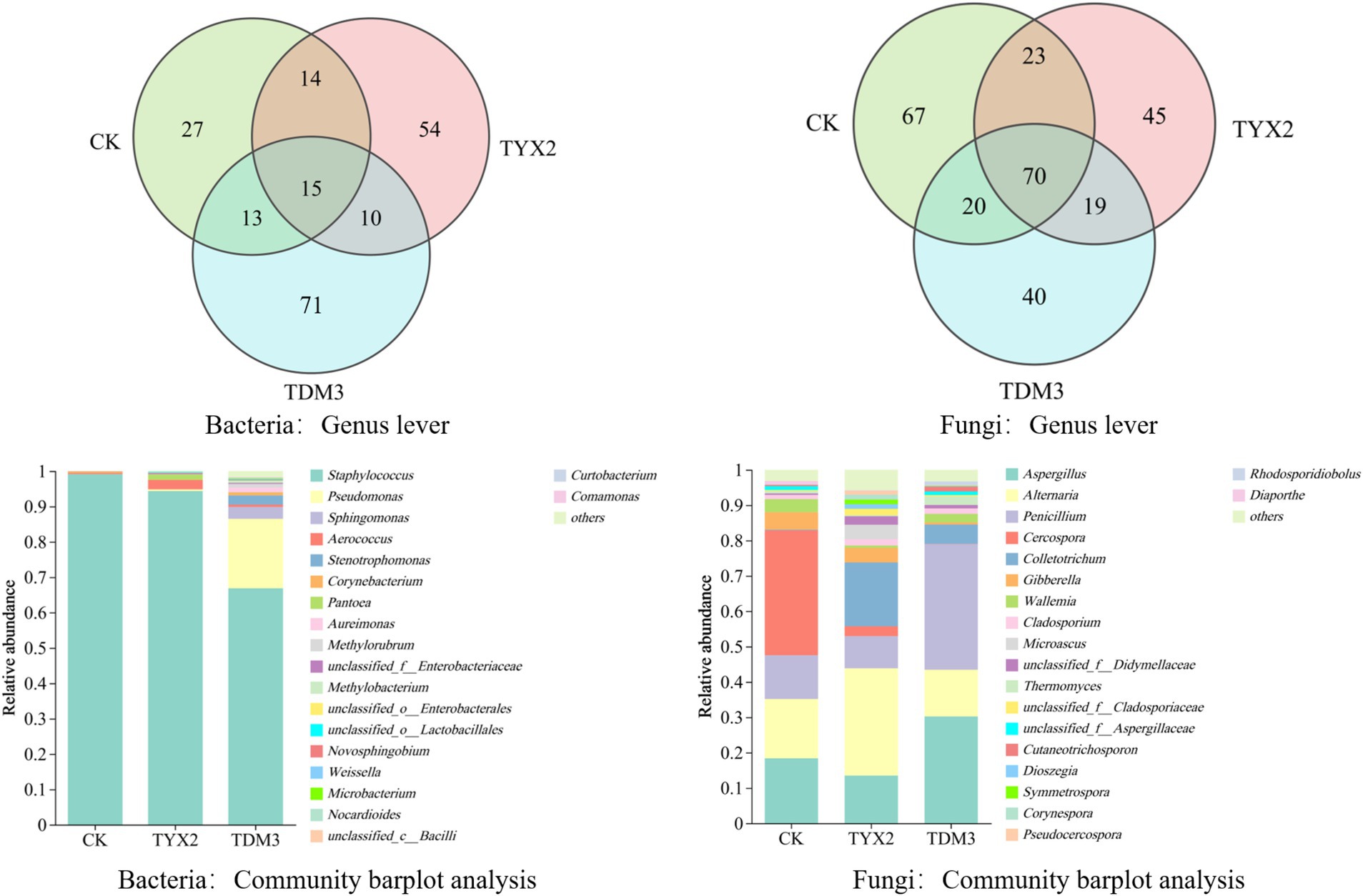
Figure 6. Microbial community composition of tobacco leaves after fermentation with pectin-degrading bacteria.
3.4 Microbial diversity index analysisFigure 7 illustrates the diversity indices of bacterial and fungal communities across different treatment groups. The Sobs index shows that the CK group had a relatively low number of species, while the TYX2 group exhibited a significant increase, and the TDM3 group had the highest number of species, significantly exceeding both the CK and TYX2 groups. This indicates that the addition of pectin-degrading bacteria, particularly DM-3, significantly enhances bacterial species richness, leading to a more diverse microbial community. The Sobs index for fungal communities followed a similar pattern. The Simpson index, where a lower value indicates higher community diversity, revealed that the CK group had a relatively high Simpson index, indicating lower diversity. In contrast, the TYX2 group showed a significant increase in diversity, with the Simpson index decreasing to 0.71. The TDM3 group exhibited the highest diversity, with the Simpson index further decreasing to approximately 0.68. This suggests that the inclusion of DM-3 significantly improved community diversity. The Simpson index for fungal communities showed a similar trend, indicating that pectin-degrading bacteria also positively impact fungal community diversity. The Shannon index results further support these findings, showing that the CK group had the lowest overall diversity in both bacterial and fungal communities. The TYX2 and TDM3 groups showed significant increases in Shannon index values compared to the CK group, with TDM3 being significantly higher than TYX2. This further confirms the significant role of pectin-degrading bacteria, especially DM-3, in enhancing microbial community diversity.
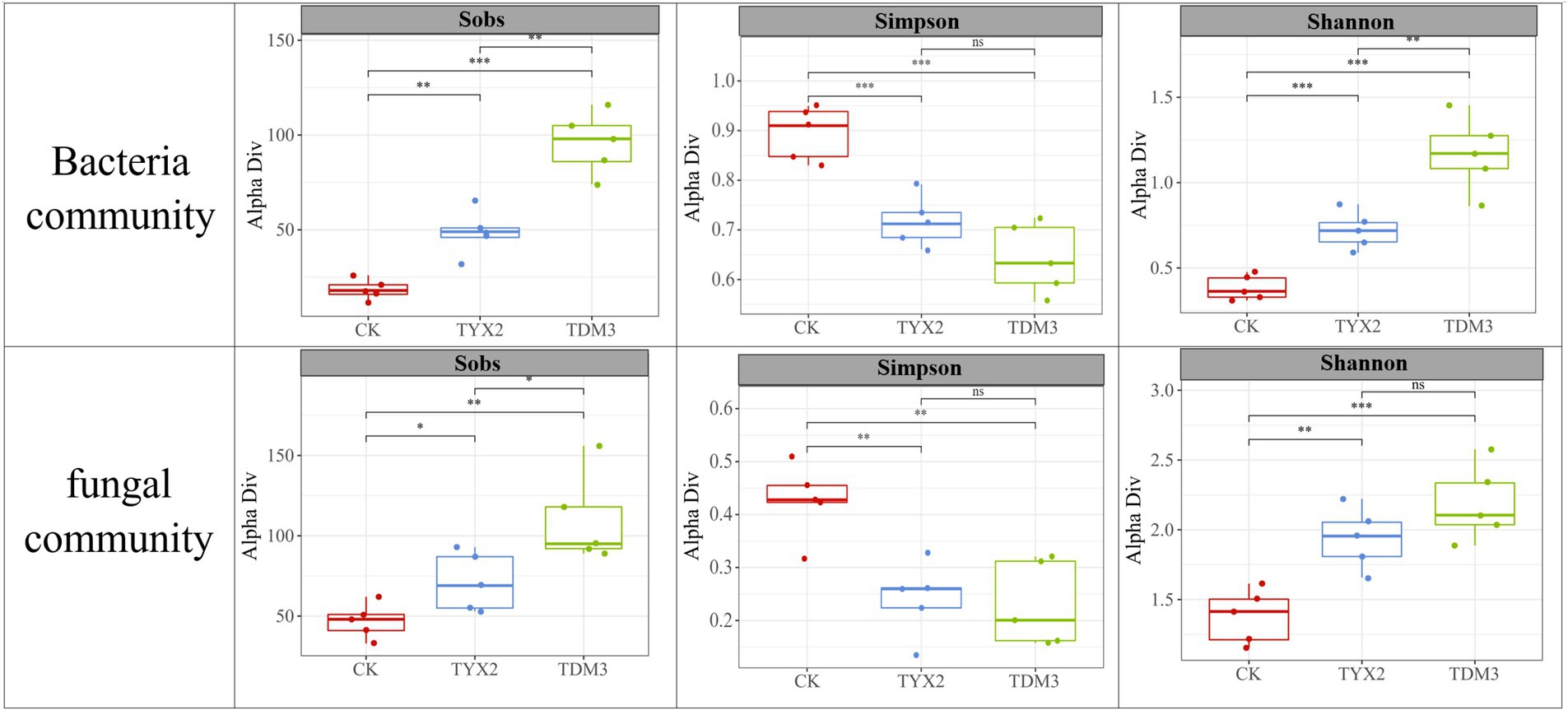
Figure 7. Differences in microbial diversity among the three tobacco leaf treatments.
3.5 The impact of pectin-degrading bacteria on genus-level species differences in cigar tobacco leavesFigure 8 shows the principal coordinates analysis (PCoA) and linear discriminant analysis (LDA) effect size of bacterial and fungal community structures during tobacco leaf fermentation. The PCoA results for bacterial communities indicate that the CK group had a relatively concentrated structure, suggesting stability. The TYX2 group displayed some dispersion, but with a clear distinction from the CK group. In contrast, the TDM3 group showed a more concentrated distribution, with significant differentiation from both the CK and TYX2 groups, indicating that strain DM-3 had a substantial impact on bacterial community structure. LEfSe analysis with an LDA threshold of 4 further revealed significant differences in specific bacterial taxa and their LDA scores. In the TYX2 group, unclassified Enterobacteriaceae were significantly enriched, suggesting their potential importance in this treatment. In the TDM3 group, Proteobacteria and the genus Pseudomonas were significantly enriched, with LDA scores exceeding 5, indicating that strain DM-3 promoted the enrichment of these bacteria. Regarding fungal communities, the structures in the three treatment groups also showed some dispersion, with clear distinctions between them, although the differences were less pronounced than in the bacterial communities. The LDA results indicated that in the CK group, Eurotiales and Cercospora were significantly enriched, suggesting these fungi were dominant in this group. In the TYX2 group, Setophaeosphaeria and Acremonium were significantly enriched, while in the TDM3 group, Eurotiales and Eurotiomycetes were significantly enriched. The dominant microorganisms varied across the three treatment groups. In summary, the addition of strains YX-2 and DM-3 significantly altered the microbial community structure during tobacco leaf fermentation, enhancing the enrichment of functional microorganisms. The TDM3 group, in particular, showed more pronounced effects, with these significantly enriched microorganisms likely playing crucial roles in improving pectin degradation efficiency, promoting the production of beneficial metabolites, and optimizing the fermentation environment.
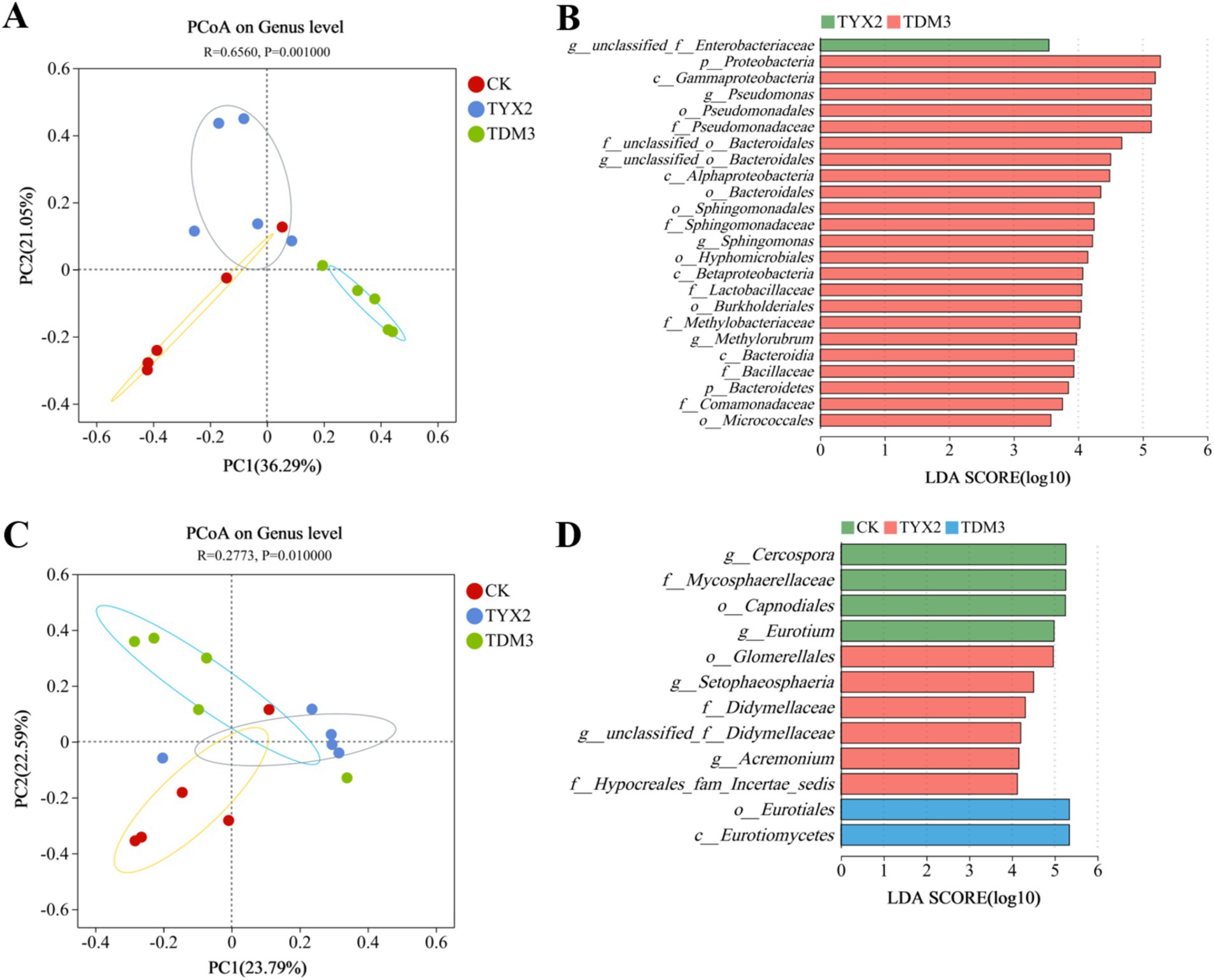
Figure 8. Effect of pectin-degrading bacteria fermentation on the differences in tobacco leaf microbial community composition. (A) PCoA of bacterial communities; (B) LDA effect size of bacterial communities; (C) PCoA of fungal communities; (D) LDA effect size of fungal communities. In the LDA vertical axis, lowercase letters p, c, o, f, and g represent the taxonomic levels of phylum, class, order, family, and genus, respectively.
As shown in the bacterial and fungal community heatmap (Figure 9), different treatment groups significantly influenced the composition and relative abundance of microbial community during fermentation. Among the bacteria, Pseudomonas emerged as a notably differential species, with significant differences in abundance across the three treatments: highest in the TDM3 group, followed by the TYX2 group, and lowest in the CK group. Additionally, several other bacterial genera, including Stenotrophomonas, Sphingomonas, Methylobacterium, and Aureimonas, exhibited significant differences in abundance across the three groups. Overall, the bacterial community in cigars fermented with DM-3 showed higher abundance compared to the other groups. In the fungal community, the genera Cercospora, Diaporthe, Microascus, and Symmetrospora demonstrated significant differences in abundance across the three treatments. Notably, Diaporthe showed extremely low abundance in the TDM3 group, moderate abundance in the TYX2 group, and high abundance in the CK group, indicating that the addition of pectin-degrading bacteria reduces the abundance of this genus within the community, making it a distinct differential species.
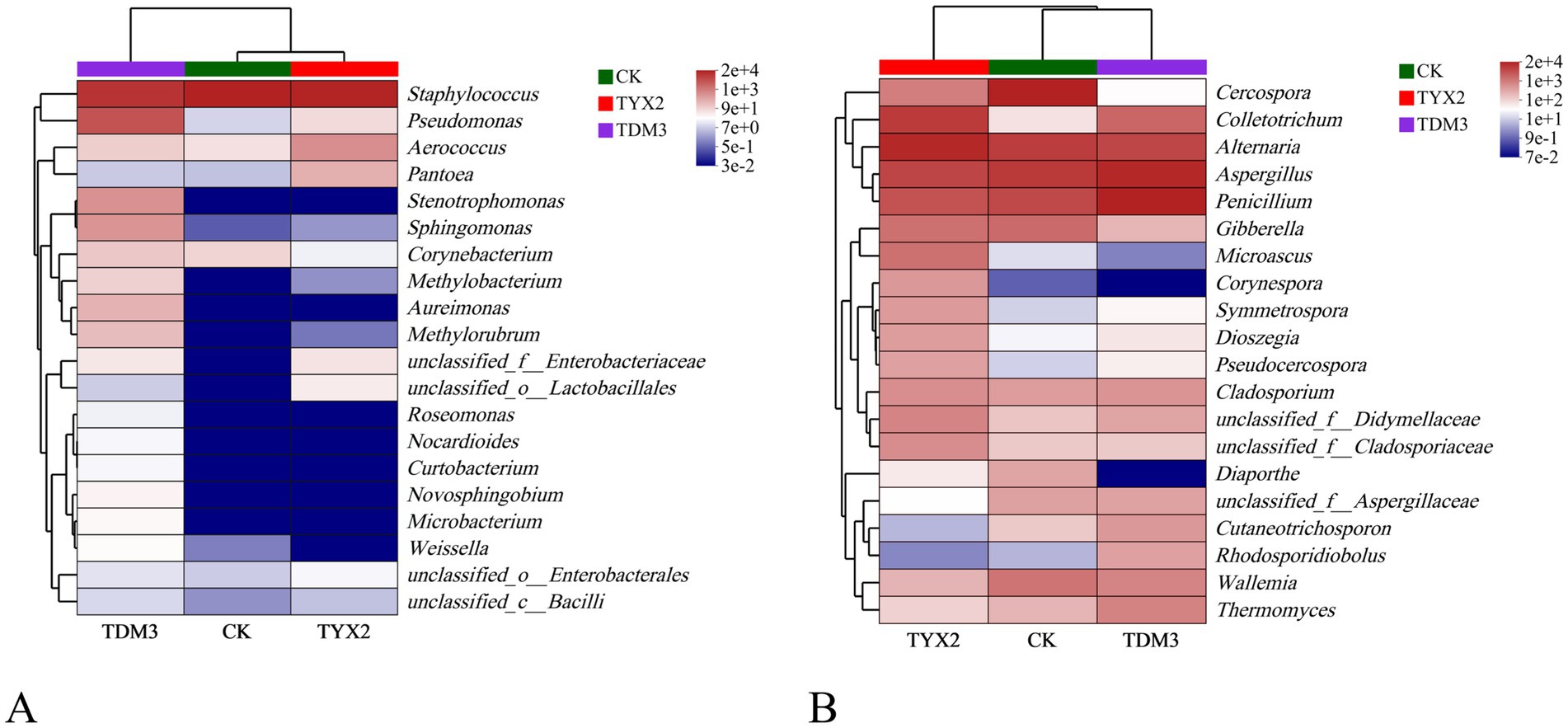
Figure 9. Heatmap of the microbial community in cigar tobacco leaves. In the legend, ‘e’ represents the exponent in scientific notation, indicating the magnitude of the values. (A) Bacterial community heatmap. (B) Fungal community heatmap.
3.6 Analysis of the association between tobacco leaf physicochemical composition and microbial communityFigure 10 presents the Spearman correlation heatmap between various bacterial and fungal species and the physicochemical properties of tobacco leaves, including total nitrogen (TN), pectin, total sugars (TS), reducing sugars (RS), and total alkaloids (TA). The results indicate that the abundance of Pseudomonas, Stenotrophomonas, and Methylobacterium is significantly negatively correlated with pectin content, suggesting that an increase in the abundance of these bacteria can lead to a reduction in pectin content. These bacteria likely play a crucial role in the degradation or indirect breakdown of pectin during tobacco leaf fermentation, contributing to a reduction in green bitterness. Pseudomonas also shows a significant positive correlation with both total sugars and reducing sugars, indicating that an increase in Pseudomonas abundance may enhance the levels of these sugars. As total sugars and reducing sugars are essential precursors of cigar aroma components, their high content can effectively enhance the flavor of cigars. Therefore, Pseudomonas is crucial in cigar fermentation; its high abundance not only reduces pectin content but also enhances tobacco leaf aroma to some extent. The addition of pectin-degrading bacteria during fermentation notably increases the abundance of Pseudomonas. On the fungal side, Cercospora shows a significant negative correlation with total nitrogen and total sugars, indicating that high abundance of this fungus may decrease these components, which could be detrimental to the formation of cigar aroma. These correlations suggest that specific microorganisms may significantly impact key physicochemical parameters during the fermentation of tobacco leaves.
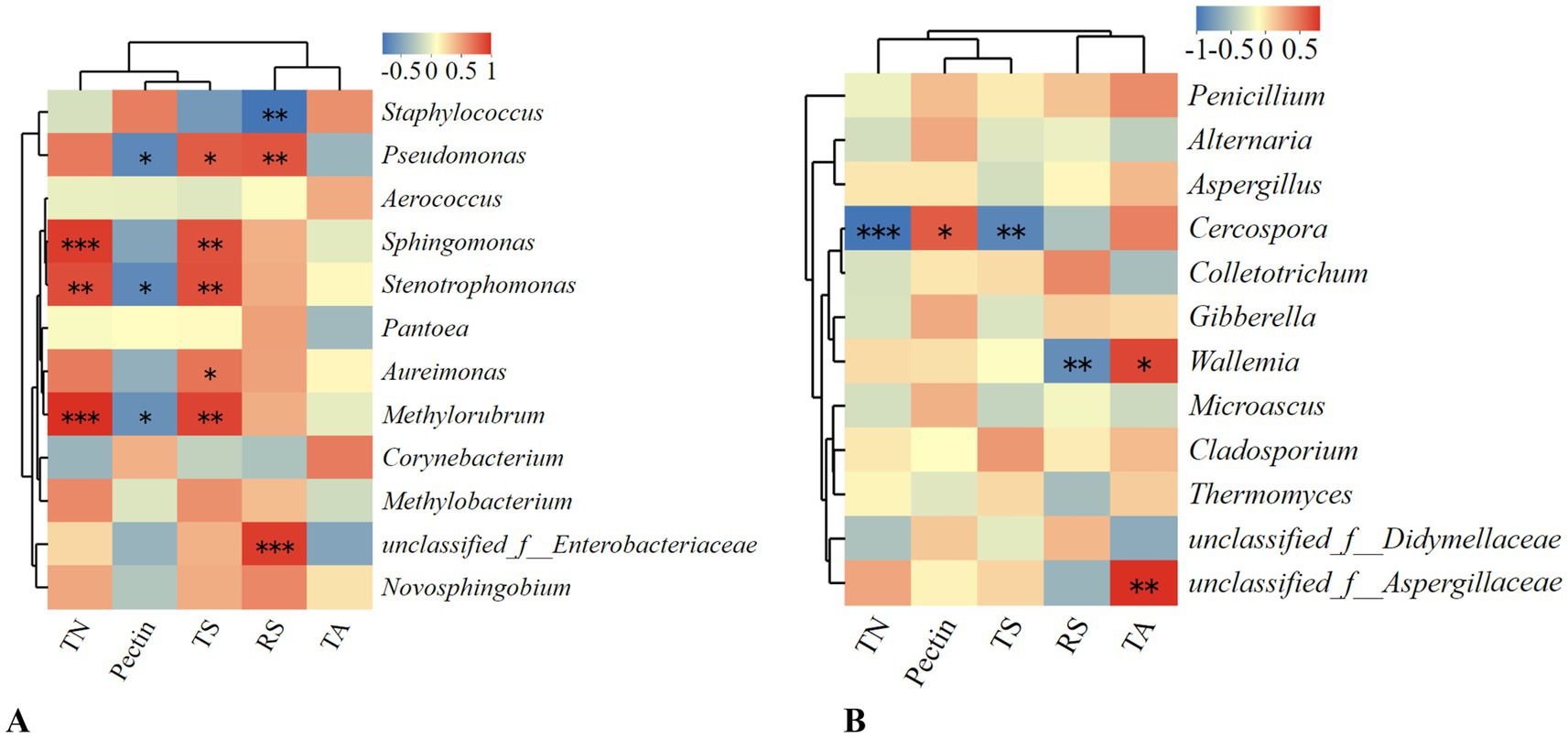
Figure 10. Spearman correlation heatmap between different microorganisms and the physicochemical components of tobacco leaves. (A) Spearman correlation heatmap of bacterial communities. (B) Spearman correlation heatmap of fungal communities.
To better understand the mechanisms and potential impacts of strains YX-2 and DM-3 during tobacco leaf fermentation, a Mantel test correlation network heatmap was generated (Figure 11). As shown in the figure, Mantel test analysis of bacterial communities and physicochemical properties revealed a strong and significant positive correlation between total nitrogen and total sugars and the bacterial community in the TDM3 group. This suggests that the addition of strain DM-3 contributes to the increase in total nitrogen and total sugars. Pectin showed a significant negative correlation with the bacterial community in the TDM3 group, indicating that in the TDM3 treatment, the bacterial community effectively degrades pectin. This aligns with previous results, confirming that DM-3 possesses strong pectin-degrading capabilities. Regarding fungal communities, the addition of strains YX-2 and DM-3 also significantly affected the physicochemical properties of the tobacco leaves. In the TDM3 group, pectin displayed a significant negative correlation, indicating that strain DM-3 plays a critical role in pectin degradation not only within the bacterial community but also within the fungal community.

Figure 11. Mantel test correlation network heatmap.
3.7 Microbial network analysisA univariate correlation network can be used to analyze the relationships between species (Figures 12A,C), reflecting the interactions among species in tobacco leaves. Staphylococcus exhibited the highest abundance and displayed numerous negative correlations, indicating its significant regulatory role within the bacterial community. It showed a significant negative correlation with several bacterial genera, such as Pseudomonas, Aureimonas, and Novosphingobium, suggesting potential competitive interactions between these genera under certain conditions. Methylobacterium and Methylorubrum displayed many positive correlations, indicating that these bacteria might cooperate during fermentation to promote certain metabolic activities. In the fungal community, Penicillium and Aspergillus were highly abundant, with Penicillium showing positive correlations with three other fungi and Aspergillus exhibiting significant negative correlations with several fungal genera, such as Dioszegia, indicating potential competitive interactions among these fungi under specific conditions. Dioszegia and Wallemia demonstrated several positive correlations, suggesting that these fungi might work together during fermentation to promote pectin degradation and other metabolic activities.
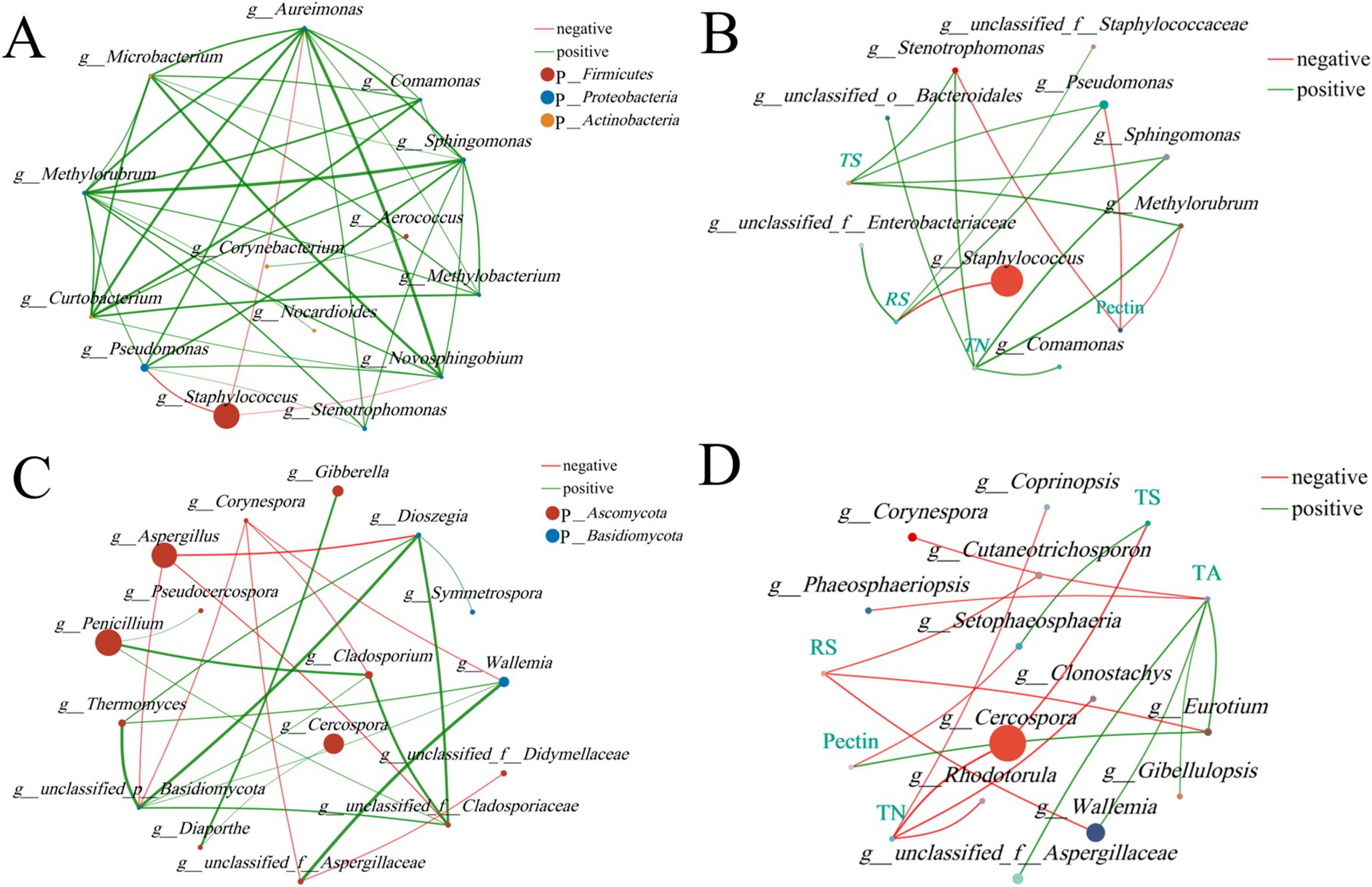
Figure 12. Correlation network analysis of fungal communities in tobacco leaves. (A) Bacterial univariate correlation network. (B) Bacterial bivariate correlation network. (C) Fungal univariate correlation network, and (D) Fungal bivariate correlation network. All results are presented at the genus level, with the top 20 most abundant taxa selected for both univariate and bivariate correlation networks. Correlation coefficient ≥ 0.5, p < 0.05.
The bivariate correlation network focuses on analyzing the relationships between species and physicochemical factors, helping to understand the interactions between species and the physicochemical properties of cigar tobacco leaves (Figures 12B,D). The results showed that Pseudomonas was positively correlated with reducing sugars (RS) and total sugars, while negatively correlated with pectin, suggesting that Pseudomonas plays an important role in carbohydrate metabolism and may contribute to the degradation of pectin in cigar fermentation. Staphylococcus was highly abundant and mainly negatively correlated with reducing sugars (RS), indicating that it may influence the accumulation of reducing sugars during fermentation through certain pathways. In the fungal community, Cercospora, which was highly abundant, was negatively correlated with total sugars (TS) and total nitrogen (TN), indicating that Cercospora may play a significant role in carbohydrate metabolism and accumulation. Eurotium was negatively correlated with pectin and positively correlated with reducing sugars (RS), suggesting that Eurotium might enhance reducing sugar content by degrading pectin during fermentation. This species appears to be important for pectin degradation, reducing green bitterness, and improving the sensory quality of tobacco leaves. Analysis of these correlation networks reveals that different treatment groups (CK, TYX2, and TDM3) significantly influence the structure of bacterial and fungal communities and their relationships with the physicochemical properties of tobacco leaves.
4 Discussion 4.1 Mechanisms underlying the enhancement of cigar quality by pectin-degrading bacteriaThis study demonstrates that the addition of strains YX-2 and DM-3 significantly reduced the pectin content in cigar tobacco leaves, thereby decreasing green bitterness and improving the overall quality of the tobacco. Pectin, a key polysaccharide in tobacco leaves, produces organic acids and other byproducts during its degradation, which are major contributors to green bittern
留言 (0)